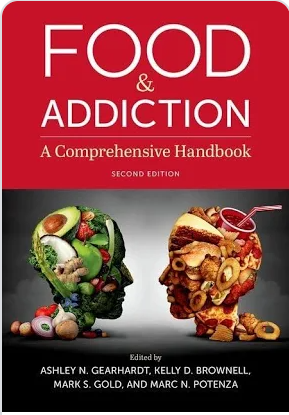Join Health Affairs for a virtual conversation between me and Angela Odoms-Young of Cornell University discussing the evolution of US food and nutrition policy, the current policy landscape, and thoughts on what lies ahead. It’s at 1:00 p.m. EDT. To join the Webinar, click here.
Weekend reading: food addiction
Ashley N. Gearhardt, Kelly D. Brownell, Mark S. Gold, and Marc N. Potenza, editors. Food & Addiction: A Comprehensive Handbook, Second Edition. Oxford University Press, 2024. 570 pages.

This is the second edition of a book I wrote about in 2012.
At the time, I said:
Brownell and Gold have produced an instant classic. Food and Addiction presents a comprehensive, authoritative, and compelling case for considering whether food is addictive. Its chapters raise serious questions about our current laissez-faire attitude toward food marketing, especially to children. This book is a must read for everyone who cares about the causes and consequences of obesity and the need for food policies that better promote health. It is a game changer. Readers will never look at food the same way again.
Much has happened since then to focus greater attention on the ways food triggers addictive-like eating behavior.
- Michael Moss’s books, Salt, Sugar, Fat, and Hooked. These document how food companies deliberately formulate products to make them irresistible (“you can’t eat just one”).
- The emergence of the concept of ultra-processed foods as a researchable category.
- Kevin Hall et al’s demonstration that ultra-processed foods encourage people to eat more calories but not realize it.
- The increase in research using the Yale Food Addiction Scale, and
- The research described and reviewed in this book.
All of this makes an increasingly convincing case that the word “addiction” applies to food as well as to other addictive substances, and that similar proportions of people (10% to 15%) meet criteria for addiction; everyone eats, but not everyone meets those criteria.
The editors’ introductory and concluding chapters lay out the diagnostic and policy issues.
The short chapters address biological, behavioral, clinical, and legal correlates of food addiction.
They are written by a authors who address these issues from enormously different , but highly critical, perspectives ranging from the exceedingly personal to the big-picture political.
Is anything missing here? As with any multi-authored book, this one undoubtedly took years to produce. That makes it a few years out of date in fast-moving areas. It does not cover recent research on ultra-processed foods, Kevin Hall’s experiment, the concept of food “noise,” or the way the new GLP-1 drugs might interact with addictive behavior.
But, this is the resource of food addiction, a great gift to the addiction-perplexed and an enormous public service at a time when it is badly needed.

